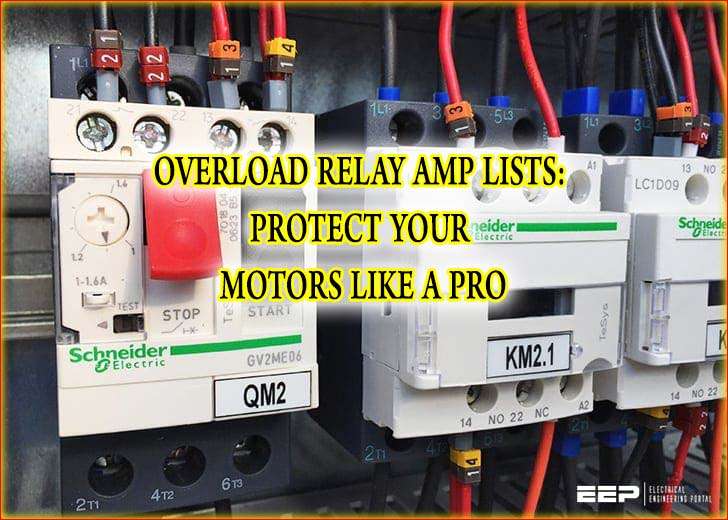Overload Relay Amp Lists: Protect Your Motors Like a Pro
Introduction: Why Your Motor’s Survival Depends on an Overload Relay Amp List
Picture this: You’ve just installed a shiny new motor for your HVAC system. It’s running smoothly… until one day, it suddenly shuts down. The culprit? An overloaded motor. Without proper protection, motors can overheat, fail, or even become fire hazards.
This is where an overload relay amp list comes in. Think of it as a “safety checklist” for your motor. It tells you exactly which amp rating your overload relay needs to prevent disasters. But if you’re new to electrical components, terms like “thermal trip” or “amp rating” might sound like gibberish. Don’t worry—this guide breaks it down in really simple way.
Table of Contents
Table of Contents

By the end, you’ll know how to pick the perfect overload relay for your motor, avoid common pitfalls, and keep your equipment running smoothly. Let’s dive in!
What Is an Overload Relay? (And Why Should You Care?)
An overload relay is like a bodyguard for your motor. It monitors the current flowing through the motor and steps in if things get dangerous. If the current exceeds safe levels (due to a jammed conveyor belt, for example), the relay trips the circuit, stopping the motor before it fries.
There are two main types:
- Thermal Overload Relays: Use heat-sensitive elements to detect excess current.
- Electronic Overload Relays: Use sensors and microprocessors for precise monitoring.
Both types rely on one critical factor: the amp rating. Choose the wrong rating, and your relay might either trip too often (annoying!) or not trip at all (disastrous!).
The Amp Rating: Your Motor’s Lifeline
The amp rating is the maximum current your motor can handle safely. Exceed this, and the overload relay intervenes. But how do you find the right rating?
Here’s a secret: Your motor’s nameplate holds the answers. Look for the Full Load Current (FLC) or Full Load Amps (FLA), which indicate the current the motor draws under normal operation. Your overload relay’s amp rating should be based on this number.
How to Choose the Right Overload Relay Amp List
Step 1: Determine the Full Load Current (FLC)
Check the motor’s nameplate for the FLC. No nameplate? Use this formula:

Example: A 5 kW motor running on 220V with 90% efficiency and a 0.85 power factor has an FLC of ~28.7 amps.
Step 2: Factor in Service Conditions
Is your motor in a hot environment? Running continuously? Multiply the FLC by 1.25 to account for harsh conditions.
Example: 28.7 amps × 1.25 = 35.87 amps. Round up to the nearest standard relay size (e.g., 36 amps).
Step 3: Check the Manufacturer’s Amp List
Most relays come with a chart matching motor horsepower to amp ratings. For instance:
| Motor HP | Recommended Amp Rating |
|---|---|
| 1 HP | 4-6 A |
| 5 HP | 15-20 A |
| 10 HP | 28-36 A |
5 Common Mistakes Beginners Make (And How to Avoid Them)
- Guessing the Amp Rating: Always calculate the FLC—don’t eyeball it!
- Ignoring Ambient Temperature: A hot garage? Derate the relay by 10-20%.
- Using the Wrong Relay Type: Thermal relays are cheaper, but electronic ones offer precision.
- Forgetting to Test: Test the relay monthly to ensure it trips at the set current.
- Mismatching Motor Size: A 10 HP motor needs a relay rated for 10 HP—no compromises!
Top 5 Overload Relays with Reliable Amp Ratings
- Siemens 3RU2 Thermal Overload Relay: Amp range 0.1–40 A. Perfect for small industrial motors.
- Allen-Bradley 193-E Electronic Overload Relay: Adjustable from 5–120 A. Great for precision.
- Schneider Electric LR9K Thermal Relay: Simple setup, 0.1–93 A range. Ideal for beginners.
- ABB TA25DU Thermal Relay: Durable, 18–25 A. Best for HVAC systems.
- Eaton XTOB Electronic Relay: 2–54 A with built-in diagnostics. A tech-lover’s dream.
Final Thoughts: Protect Your Investment
Choosing the right overload relay amp list isn’t just about numbers—it’s about peace of mind. A well-protected motor lasts longer, runs efficiently, and keeps your workspace safe.
Pro Tip: Bookmark this guide and share it with your team. And if you’re still unsure, reach out to the manufacturer for personalized advice.
FAQs: Overload Relay Amp Lists Demystified
What happens if I pick the wrong amp rating?
Too low = nuisance tripping. Too high = motor burns out. Always match the FLC!
Can I adjust the amp rating after installation?
Yes! Electronic relays have dials or digital interfaces. Thermal relays require swapping heaters.
What’s the difference between thermal and electronic relays?
Thermal relays are budget-friendly but less precise. Electronic relays cost more but offer accuracy and diagnostics.
How often should I check my overload relay?
Test it monthly. Dust and corrosion can affect performance.
Do I need a separate relay for each motor?
Yes. Each motor has unique FLC requirements.
Can I use a 30A relay on a 25A motor?
Only if you adjust the rating down to 25A. Never exceed the motor’s FLC!
Where can I find amp lists for my relay model?
Check the manufacturer’s manual or website. Most provide downloadable PDFs.
Follow Us on Social:
Subscribe our Newsletter on Electrical Insights to get the latest updates in Electrical Engineering.
OverloadRelay #MotorProtection #ElectricalSafety #OverloadRelayChart #ThermalOverload #ElectricalEngineering #MotorOverload #RelayAmpRating #IndustrialAutomation #OverloadProtection #MotorControl #ElectricalMaintenance #PowerSystems #ElectricalDesign #AmpRatings
